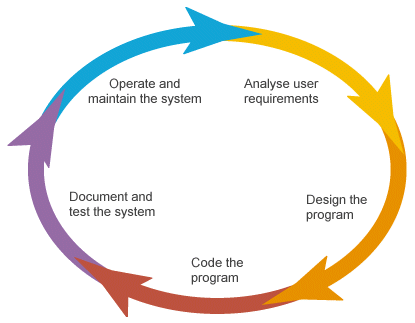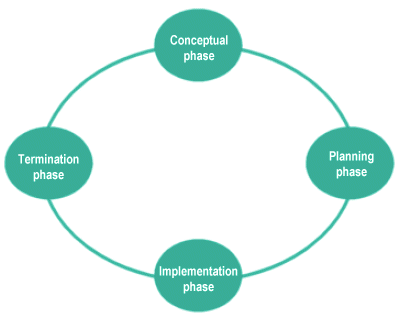There is no single project lifecycle model that fits all kinds of project. Each industry or application area has its own distinct model with very specific characteristics (a simple software development life cycle model is illustrated below). Even within a particular application area both the model used and its precise interpretation can vary. In every case, however, the lifecycle model provides project managers with a structure within which work can be identified and organised into phases. Once an appropriate life cycle model has been selected, its structure can be used to form the basis for developing the project plan.

A simple Software Development Life Cycle (SDLC)
In the absence of an application-specific life cycle model, a generic model can be used to provide the necessary framework. The following phases might form part of such a model:
- Conceptual phase - the project proposal is developed, objectives and constraints are identified, and the feasibility of the project is assessed (this will normally involve making a rough estimate of project cost, the human resources required and the timescale over which the project activities will take place). The phase may also include the identification of project milestones and an assessment of risks associated with undertaking the project.
- Planning phase - assuming the decision has been taken to proceed with the project, detailed planning must now take place. The scope of the project will be defined and work will be scheduled and allocated to workgroups or individuals as appropriate. A detailed schedule of the resources required will be produced, and a detailed project budget will be prepared. The project budget, together with the various schedules that are drawn up, will constitute the baseline against which progress will be measured. It is at this stage that the tools and techniques that will be used to manage, monitor and evaluate the project, including any specialist software packages, will be identified.
- Implementation - the product or service that is the subject of the project will be produced and tested during this phase, making it the most intensive phase of the project in terms of expenditure and effort. The kind of project management activities that take place during this stage will include the management of change - depending on the nature of the project, the requirements (or scope) of the project may change as time goes by. Other activities will include monitoring expenditure to ensure that the budget is adhered to (or if necessary amended), and work carried out to ensure that any delays are flagged up and dealt with promptly (this could entail making changes to the schedule of work or a re-allocation of resources).
- Termination - this phase, sometimes overlooked when aspects of project management are being considered, is where loose ends are tidied up and the relative success or failure of the project is evaluated. Depending on the type of project being undertaken, it may include a process of handover whereby the customer or end user takes ownership of the new product or service, and is given all of the necessary documentation (e.g. user manuals, technical documentation, certificates of compliance and so on). An audit may be carried out to assess how well (or badly) the project was managed, and to derive any lessons to be learned for future reference.

A simple generic project life cycle
The project life cycle model can be used as a framework within which to plan project activities and to define project milestones. Each phase of the life cycle will be associated with a specific set of deliverables which can be evaluated against the planned objectives for the current phase, and which will form the foundation on which the next phase of the life cycle will build. The end of each phase will be a significant project milestone. In many projects, the phases of the life cycle model used will form the basis for the Work Breakdown Structure (we will look at this in some detail elsewhere), which is used to define and organise the units of work that must be undertaken during the project’s lifetime, and which forms the basis for the project plan. The standard assumption is that each phase will be completed before the next phase begins, although there are invariably exceptions to this rule.

